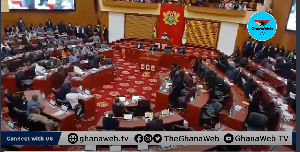TOPIC: An Assessment Of An Environmental Problem In Ghana AND PROPOSED SOLUTIONS BASED ON ENVIRONMENTAL ECONOMIC PRINCIPLE
www.salimnuhu.blogspot.com/2013/11/illlegal-small-scale-mining-galamsey-in.html
Having grown up in the gold-mining townships of Obuasi, I am left with no option than to discuss environmental degradation as an effect of artisanal small-scale unauthorized mining; popularly known as GALAMSEY. Small-scale mining is usually common in areas that are rich in gold, diamonds, salt, kaolin, silica, sand, brown clay, aggregates and crushed rocks, etc. However, most artisanal small-scale miners popularly referred to as ‘galamsey’ engage in gold mining.
Setting off on the economic premise that the environment is an asset, we realise that one of the world’s most valuable and precious minerals; gold, is found within it. Gold is a product of the environment and a gift of nature. Having looked at gold as an asset of the environment, I proceed carefully to analyse the relationship between man and gold as a component of the environment through mining: legal large-scale and illegal small scale-galamsey. Galamsey operations, which involve the extraction of minerals from the environment into the economic system in the form of saleable minerals aptly, fits the first law of thermodynamics; the materials extracted either remain in the economic system as revenue and ornaments or returns fully or partially into the environment in the form of arsenic trioxide, cyanide and other forms of industrial waste.
The extraction of gold releases arsenic trioxide, sulphur dioxide, and cyanide into the environment. Mercury, a heavy metal, is also introduced by small scale illegal miners for gold extraction. The use and management of cyanide and mercury in the process of gold mining is a practice about which many environmental scientists and economists continue to raise concerns, especially given that, whatever is used in the extraction of gold either stays as revenue, real gold etc. or returns to the environment as harmful waste substance (treating the earth as a closed system). Galamsey is an important economic activity which has the potential of contributing to the development of areas endowed with the resources. However, communities with galamsey operations suffer high rates of environmental pollution. To this effect, fingers are quickly pointed at galamsey operators as the cause of the environmental problems in their operational areas.
It was in view of this that the government of Ghana in July, 2013 tasked a joint police, military and immigration team to flush out illegal mining operators which led to the arrest of over 270 Chinese and other foreign nationals. However, as I have been taught as a student of environmental economics,
//I am compelled to do a cost-benefit analysis of galamsey as an environmental problem. The decision thus to advocate for or against it, will be based on this analysis. This is clearly demonstrated in the succeeding paragraphs.
According to the World Bank Group, “Small-scale mining is largely a poverty-driven activity, typically practiced in the poorest and most remote rural areas of a country by a largely itinerant, poorly educated populace with few employment alternatives”. In Ghana currently, there are over 300 registered small-scale mining groups and they constitute a major source of employment for the youth. According to the 2008 Ghana Chamber of Mines (GCM) report, illegal mining activities (Galamsey) had been increasing with an estimated number between 300,000 and 500,000 galamsey miners comprising one of the largest groups of illegal miners on the continent.
Revenue generated from this small scale mining increases household disposable income (which in this case is the exact revenue from sales since they are not taxed), create more employment, open the doors for more investment, and help finance agricultural and economic activities like trading since these operators normally save their proceeds with the rural banks and microfinance institutions. The increase in their disposable incomes has always tended to have a healthy effect on local economic activities. It increases demand for goods and services, adds up to aggregate expenditure and subsequently, overall production.
There have even been some instances when organised galamsey groups have taken up the social responsibility of rehabilitating schools, community centres, fixing non-working street lights and making generous donations to under-privileged groups in their catchment areas. This goes to contribute to the improving the nation’s standard of living .
Nonetheless, as economic principle requires, decisions on such a critical environmental issue cannot be made without a detailed assessment of the costs: both monetary and environmental (social costs).
Galamsey operations yield high levels of negative externalities. In Ghana, the principal environmental problems caused by small-scale mining activity are mercury pollution from gold processing, water pollution and land degradation. As is the case in most developing countries, mercury is heavily relied upon for gold extraction as it is a cheap, dependable, portable operation for concentrating and extracting gold from low-grade ores. It is now well known, however, that the chemical, in sufficient quantities, poses a serious threat to human health and a wide-range of ecological groupings. It has the tendency of weakening one’s immune system, life expectancy government’s expenditure on healthcare and subsequently the productivity of the country’s labour force.
A second major environmental impact of small-scale gold mining in Ghana is land degradation — more specifically, clearing vast expanses of forest, digging trenches and the upturning of vegetation which in turn leaves land bare and exposed to agents of erosion. It is quite common for prospective sites to be stripped bare of vegetation topsoil, and where deep underground mining has occurred, that pits are left uncovered and abandoned.
Galamsey operations have also resulted in the pollution of many water bodies across the country. In October 2013 for instance, the Ghana Water Company Limited shut down one of its treatment plants at Odaso which supplied water to parts of Obuasi and surrounding areas in the Ashanti Region because the cost of chemicals used for the treatment of water from the Oda River skyrocketed due to the pollution of the river by illegal mining operators. Despite these environmental damages, the dangers that the galamsey operators themselves are exposed to cannot be over looked. We often hear on news the death of illegal miners caused by a collapsed cave or them being buried alive in collapse pits. These losses are costs to the nation’s human resource base since most of the people engaged in it are youth in their prime ages. Aside the ones stated above, there is prevalent very low living standards, poverty, lack of basic needs such as portable water, huge pits that have been left uncovered from excavation activities are also among the threats posed to these illegal mining communities.
It is clear from the foregoing arguments that illegal small-scale mining-galamsey, seemingly the nation’s current distressing environmental headache, has some economic benefits- though not accurately measurable, and also comes with enormous costs to both human and ecosystems. However, in a period of rising unemployment and decline in consumption expenditure in Ghana, galamsey will be of great boost to the economy if properly regulated to meet standard operational requirements. This is because, unlike most of the giant multi-national mining corporations in Ghana, profits and revenue generated from galamsey is retained in the country in the form of consumption expenses and savings with local Ghanaian banks instead of being flown outside the country. Accordingly, based on environmental economics principles, I propose the following solutions towards dealing with galamsey as an environmental challenge. In line basic economic logic that every gain comes with opportunity costs, it is of essence we recognise that small-scale mining will come at a cost of some loss of the precious environment.
First there should be a comprehensive plan on galamsey operations that will seek to register, monitor and regulate their operations for purposes of taxation and penalisation when there is a breach of regulation. To deal with land degradation, as part of this comprehensive plan, government should impose a levy on them for reclamation of the lands they explore. The revenue generated should then be deposited in special accounts to be set up for this purpose by the Metropolitan, Municipal and District Assemblies under whose jurisdiction these miners operate. The funds would then be invested in afforestation of reclaimed lands that were hitherto explored by ‘galamseyers’.
On the issue of water pollution, MMDAs can dig mechanised boreholes in operational areas of galamseyers and charge the operators on a pay-per-use basis. This will prevent them from polluting entire water bodies and also help assemblies to generate extra revenue to support projects aimed at sustaining the environment.
On the use of heavy poisonous metals such as mercury for gold extraction, the Environment Protection Agency will have to play a supervisory role in ensuring that galamsey operators comply with chemical use requirements and also form consortiums that are large enough to acquire the infrastructure necessary to ensure that these poisonous chemicals are not released into the environment. Government should also put in place as a matter of urgency; environmental courts and a polluter pay policy as well as build the capacity of law enforcement agencies on environmental issues to aid prosecution of those contribute to environmental degradation.
In conclusion, streamlining of operations, training, application of technology and policy development by the government of Ghana can reduce the negative environmental impact of galamsey so as to boost investment, create jobs and also support initiatives at sustained community and environmental development. It should not be banned or discarded!
REFERENCES:
Ghana Chamber of Mines Report (2008),
www.ghana.gov.gh ,
GALAMSEY-An Opportunity or Problem (Gab Norgah, Ghanaweb May2013)
A Contextual Review of the Ghanaian Small-scale Mining Industry-(Gavin Hilson Imperial College Centre for Environmental Technology, London, UK)
THE WRITER, AHMED SALIM NUHU IS A STUDENT OF ECONOMICS, KNUST
Opinions of Tuesday, 10 December 2013
Columnist: Ahmed, Salim Nuhu
An Assessment Of An Environmental Problem In Ghana
Entertainment













